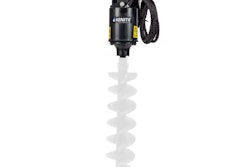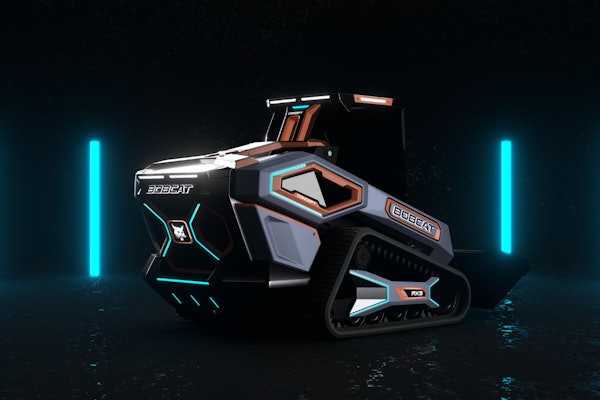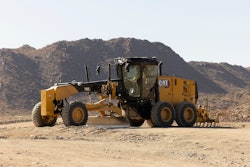Best-known for its compact tractors, Kioti has been teasing the construction world for the past few years with plans to roll out its first skid steer and compact track loader.
After the long wait to market, the new TL750 compact track loader and SL750 skid steer are here.
On this episode of The Dirt, we hear from Kioti Product Manager Justin Moe about what sets the new loaders apart and what customers can expect.
Some features on the new models include hydraulic pilot controls, a roll-up door and wide cabs.
To find out more about why Kioti decided to enter the construction market and its first products in the segment, check out the latest edition of The Dirt.
Equipment World serves up weekly videos on the latest in construction equipment, work trucks and pickup trucks – everything contractors need to get their work done. Subscribe and visit us at equipmentworld.com!
In This Episode:
- 00:00 - Kioti Compact Equipment
- 00:35 - What Kind of Company Is Kioti?
- 02:01 - Is Kioti a New Company?
- 03:17 - What Sets Kioti Compact Equipment Apart?
- 05:15 - EH vs Pilot Controls
- 06:49 - Roll Up Door
- 07:42 - Larger Cab Size
- 09:09 - Value in the Right Places
- 09:40 - Warranty
- 10:28 - Final Thoughts
Bryan Furnace (00:09):
Today we're here to talk about a name that might not come to mind first. When you're thinking of compact equipment, it's KIOTI. If you haven't heard of them, you're not alone, but don't write them off because they're getting into the compact equipment market, and one of the things I like about their stuff is they have true pilot controls. Here to talk more about this is Justin from KIOTI.
(00:36):
Well, Justin, thank you so much for your time. Thanks for being on the show today. I appreciate it.
Justin Moe (00:40):
Yeah, absolutely. Thanks for having me on the show. I'm really excited to be on and talk about KIOTI's new offerings.
Bryan Furnace (00:46):
So you guys aren't one of the bigger names in the industry. In fact, I would venture to say most of my audience probably hasn't heard the KIOTI name. Could you give us just kind of a quick overview of who you guys are?
Justin Moe (00:56):
Yeah, absolutely. KIOTI is the North America brand name of our parent company, Daedong. We've been around building our brand for 30 plus years now here in the US. And you're right, we're not as large as some of those bigger manufacturers, but we're expanding really quickly and we're really building out our dealer network. Traditionally, we've been pretty heavy in the East Coast here, but we're starting to expand out to the West Coast, Midwest, opening up new dealerships every year and it's been really exciting, especially with this new construction line of equipment we're coming out with as well.
(01:29):
We started out with tractors has been our specialty for a long time. The compact tractor sector, especially, going from that kind of residential garden tractor all the way up to, now, we have some larger scale utility tractors getting all the way up to that 115 horsepower going to the larger agriculture like some of those custom hay guys that you have.
(01:48):
Yeah. We've really been building our brand, building our name within the industry, especially in the tractor. Now we got UTVs, zero turns and like I said, the construction line as well with the skid steers and the compact track loaders.
Bryan Furnace (02:01):
Got you. I do think it's important to let the audience know, while you guys are kind of new getting into the construction sector, you guys aren't strangers to the dirt. I mean one of your core business products is the compact tractor line and like you said, even getting into that 115 horse model, you've got some bigger dirt machines out there in the market currently.
Justin Moe (02:22):
Correct. Correct. That was one of our big pushes for moving into the construction line is some landscapers use compact tractors within their normal operations, sometimes interchangeable with how they use a skid-steer. Maybe they put some sort of a plane or a grader off the back of the tractor to do fine grade on finishing some jobs. When we started looking in this construction sector as an opportunity for us, we found that our dealers and our customers were already really demanding it. They're like, "You guys have been building this great tractor for years." We have our own engines, we put in all our own units, so anything diesel that's KIOTI, it's our own engines we put into it. We've had these proven engines out there for years, which has been fantastic. Yeah. That was a big push for us to move into this track loader and skid-steer market was we already had that demand from our customers and our dealers, them knowing our product already within tractors.
Bryan Furnace (03:16):
Interesting. What would you say, on the compact equipment side, what sets KIOTI apart from some of your competitors?
Justin Moe (04:44):
That's a great question. For me, one thing that stands out, I've run a lot of different equipment from one ton excavators, all the way up to 40, and dozers, everything, stuff like that and big thing for me is operator controls, being able to have very attentive controls. We have hydraulic pilot controls for all our units. So what that gives you is it gives you very attentive and very accurate controls, very speedy as well. So especially experienced operators will really like the controls we currently have on our units.
Bryan Furnace (05:16):
That is, in my mind, one of the biggest selling points of your machines. We're in this age of technology here in construction, everyone is very excited to tout their EH controls. I will give it to them, it does give you a tremendous amount of flexibility in being able to customize the cab and the button layout and everything, but one of the biggest drawbacks that no one really wants to talk about on the manufacturer side is, for us in the cab, all of our feel comes from our hands and that totally leaves with EH controls and we have to relearn how to kind of get the feel for the machine. For you guys to still have pilot controls. I know as an old school operator and a lot of others like me in the business, that is a huge advantage over the EH controls.
Justin Moe (05:58):
Yeah, absolutely. Absolutely. Yeah. Like you said that haptic feedback to the operator is huge, especially when doing finished grade or pushing out large dirt piles, being able to have that nice control and being able to really get a feel for your machine to work effectively. I'd say another thing that works really well for us, for operators, we try to make an operator centric design. We have all the auxiliary controls on your pilot joysticks as well, so multifunction attachments such as snowblowers, six-way blades.
Bryan Furnace (06:29):
You're not doing one of these numbers where you're trying to work the console? Yeah. Yeah.
Justin Moe (06:36):
Yep, exactly.
Bryan Furnace (06:37):
Awesome.
Justin Moe (06:38):
Yeah. We really wanted to make it a multi-function, multi-use machine. Going back to that operator control, that's a big thing for me, personally, and that's one thing I think we've done very, very well on this machine.
Bryan Furnace (06:49):
If I remember right, you guys also have the roll up door on your cab. Is that correct?
Justin Moe (06:55):
Absolutely. Absolutely. That's another big one, especially within landscaping jobs where you see maybe a smaller format where you're working with the crew and you have that constant communication. That roll up style door really helps operators communicate with their outside crew. If they're hopping in and out of the unit a lot, it makes it a little easier for them, especially depending on what kind of attachment you have on the unit. Having that simple roll up door makes it really easy for them to get in and out.
Bryan Furnace (07:20):
That is one of the most irritating things in a lot of the competitor machines is when you've got a mulcher or something on the front and you set it down on the ground, you think you've got the implement all the way down the ground. It's all real quick, you throw the lap bar up and you go to hit the door, bunk, Now I've got to put the lap bar down and put the button again.
Justin Moe (07:38):
Complete agreeance. Complete agreeance with you. Yeah, that's another thing. With the cab too, I'm kind of a big guy, I'm six foot three, I usually don't fit in compact equipment very well. When I got in these skid steers for the first time, I was pleasantly surprised. We have ample room. The big thing I always tout is our width on the cab.
Bryan Furnace (07:58):
Interesting.
Justin Moe (07:58):
We have a very wide cab. Like I said, I'm a larger guy, we got the height, so I'm not hitting my head on the ceiling or anything like that, but we've also got the width. I have broad shoulders. I'm able to kind splay out, get my arms in a good position to feel comfortable for the day. Then even on the floorboards where you're looking down where you set your feet, sometimes with some of these units you have a narrow space where if you have larger boots on, it's kind of hard to set your feet there. We have a very wide, broad space so you can kind of adjust your legs to whatever's comfortable for you. For me, that was a huge thing that I always like to point out the shows, and that's usually noticed pretty quickly by a lot of the operators.
Bryan Furnace (08:34):
A lot of the cabs, I will agree with you, they don't really feel like they've been engineered so much for operator comfort as much as they've been engineered to, nowadays especially, show off all the bells and whistles. There's a lot of bells and whistles in these compact equipment that you go, that's great, but like we talked about, I'm banging the door on the implement every time I try to get out. You've got tiny foot space, it's cramped in the cab. Visibility is never a huge priority. It's things like that that really suffer. It's good to hear you guys are designing more for the comfort side and the usability side of the operator rather than all of the fancy tech.
Justin Moe (09:09):
Yeah, exactly. That's one thing too, right now our current product, we're driving value in the correct areas for the customer, in my opinion. Yeah, we might not have every single fancy bell and whistle right now in our current units, but that's not to say we won't have those in the future. We're already looking at our product, looking what we can bring to the customers in the future, but what we have right now is a phenomenal product that is a great performer at a great cost point. We're driving really good value while still getting a really good cost point for our customers.
Bryan Furnace (09:40):
Excellent. Well, my final question for you is, if I were to get into one of these units, what am I looking at from a warranty standpoint?
Justin Moe (09:47):
Three year, 3000 hours. Generally you see around that two year, 2000 hours is a standard warranty on the equipment. We brought in the three year, 3000 hours right away. Part of that is that we have our own engine within this unit so [inaudible 00:10:01] is a really big one. We are confident in our engineering ability and our engines that we're ready to stick that three year, 3000 hours right away. Looking in the future, we'll definitely look to have more opportunities for extended warranty if customers want it, but we're right here to stand behind our product. We're excited to get it out there.
Bryan Furnace (10:21):
Awesome stuff. Well, Justin, thank you so much for the time. I appreciate it.
Justin Moe (10:25):
Yeah, absolutely. Thank you again for having me on. It was really awesome talking with you.
Bryan Furnace (10:29):
Well, thank you again for KIOTI and Justin taking his time to come on the show to talk to us about why they decided to get into the compact equipment market and what you could expect from them going forward. As always, I hope this helps you and your business. We'll catch you on the next episode of The Dirt.










